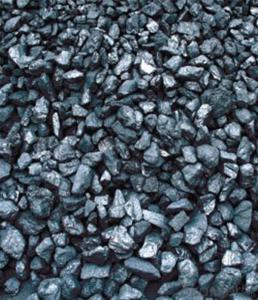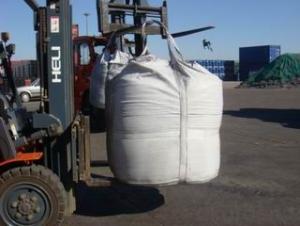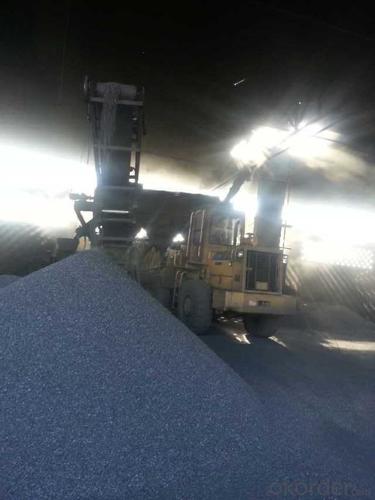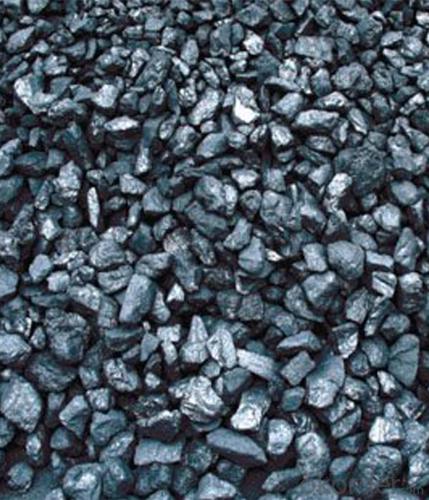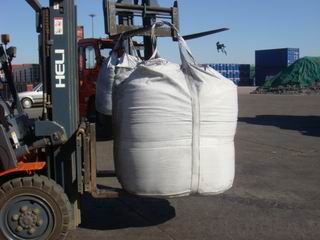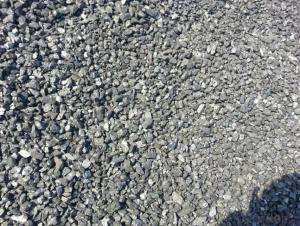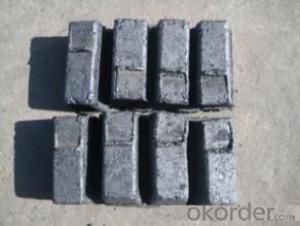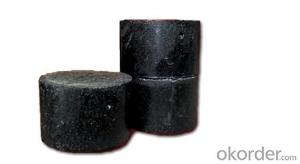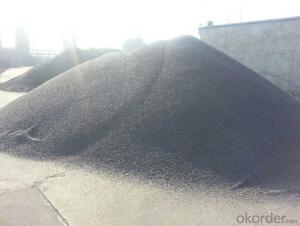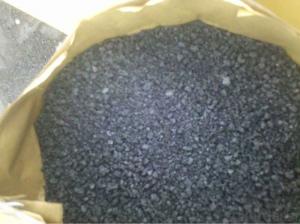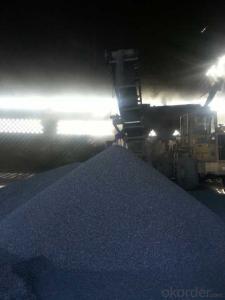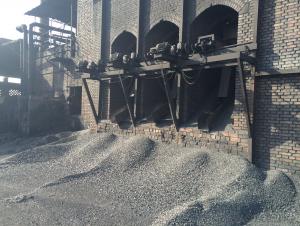FC 95% GAS Calcined Anthracite CNBM Supply
- Loading Port:
- China Main Port
- Payment Terms:
- TT or LC
- Min Order Qty:
- -
- Supply Capability:
- -
OKorder Service Pledge
OKorder Financial Service
You Might Also Like
FC 95% GAS Calcined Anthracite CNBM Supply
Specifications
Calcined Anthracite
Fixed carbon: 90%-95%
S: 0.5% max
Size: 0-3. 3-5.3-15 or as request
Description:
It used the high quality anthracite as raw materials through high temperature calcined at over 2000 by the DC electric calciner with results in eliminating the moisture and volatile matter from anthracite efficiently, improving the density and the electric conductivity and strengthening the mechanical strength and anti-oxidation. It has good characteristics with low ash, low resistvity, low sulphur, high carbon and high density. It is the best material for high quality carbon products.
Usage:
It is widely used in filtration, bleach, decoloration, water & air purification, gold extraction, soil improvement, etc
General Specification of Calcined Anthracite:
PARAMETER UNIT GUARANTEE VALUE | |||||
F.C.% | 95MIN | 94MIN | 93MIN | 92MIN | 90MIN |
ASH % | 4MAX | 5MAX | 6MAX | 7MAX | 8MAX |
V.M.% | 1 MAX | 1MAX | 1.5MAX | 1.5MAX | 1.5MAX |
SULFUR % | 0.5MAX | 0.5MAX | 0.5MAX | 0.5MAX | 0.5MAX |
MOISTURE % | 0.5MAX | 0.5MAX | 0.5MAX | 0.5MAX | 0.5MAX |
Size can be adjusted based on buyer's request.
Pictures of Calcined Anthracite:
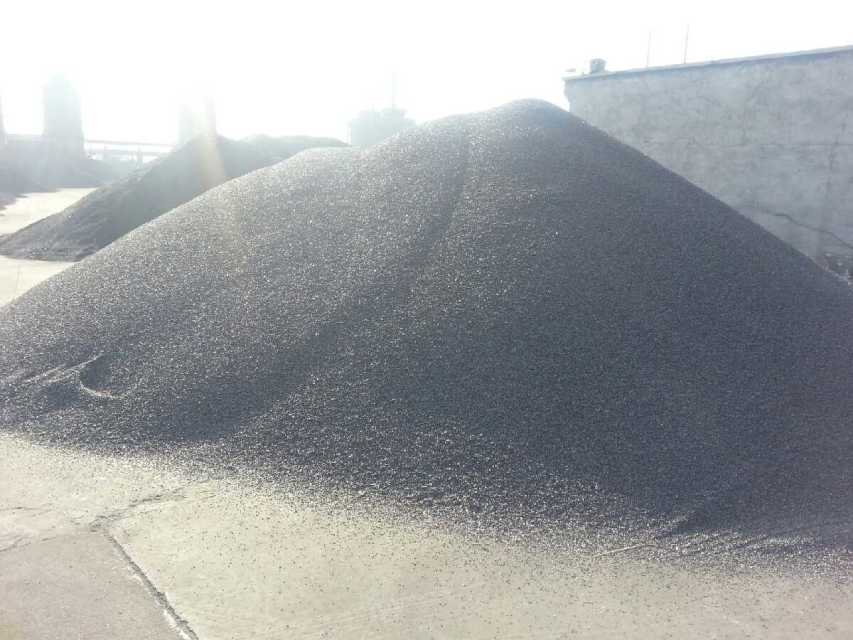
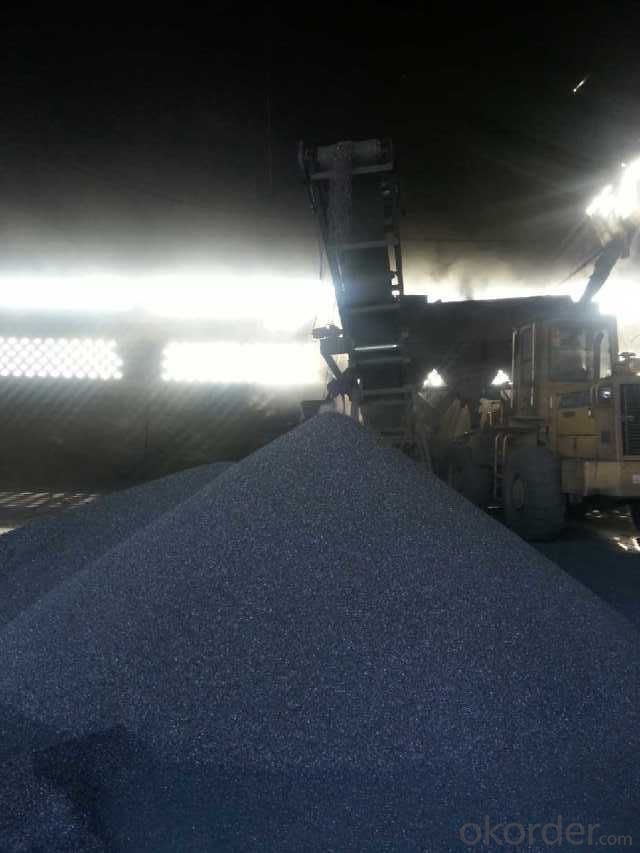
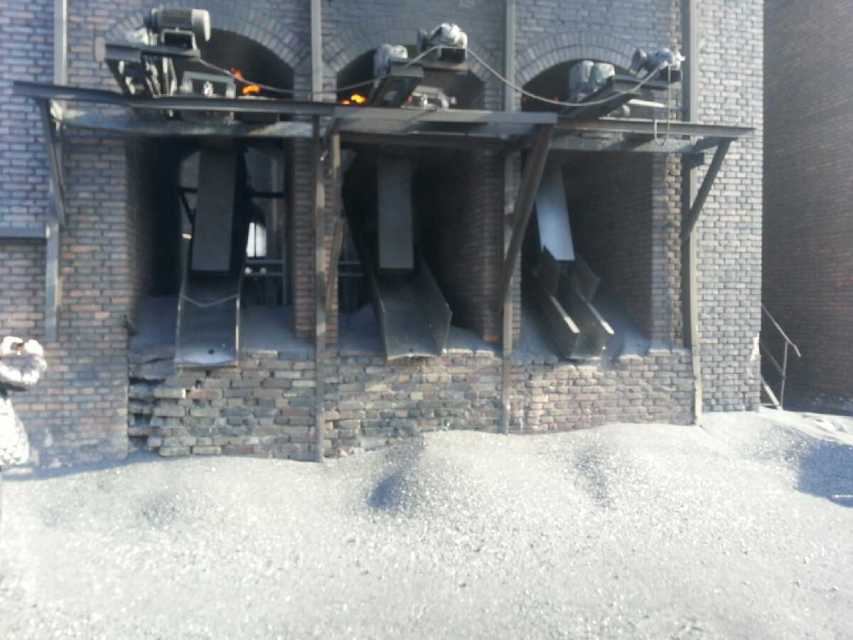
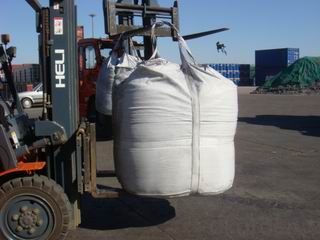
We can supply below furnace charges, please feel free to contact us if you areinterested in any of any of them:
Coke (Metallurgical, foundry, gas)
Calcined Anthracite with fixed carbon from 90% to 95%
- Q: What is carbon nanosensor?
- A carbon nanosensor is a nanoscale device made from carbon-based materials that is used to detect and measure the presence of specific molecules or substances at the nanoscale level. It utilizes the unique properties of carbon nanomaterials to provide high sensitivity and accuracy in sensing applications.
- Q: What are the advantages of carbon-based nanoelectronics?
- Carbon-based nanoelectronics offer several advantages over traditional silicon-based electronics. Firstly, carbon-based materials, such as nanotubes and graphene, have exceptional electrical properties. They can carry high electron mobility, meaning they can transport charges at a much higher speed than silicon. This allows for faster and more efficient electronic devices. Secondly, carbon-based nanoelectronics have excellent thermal properties. They can efficiently dissipate heat, reducing the risk of overheating in electronic devices. This is particularly beneficial for high-power applications, where heat management is crucial. Additionally, carbon-based nanoelectronics are extremely thin and flexible. Nanotubes and graphene can be easily manipulated to create ultra-thin and flexible electronic components. This enables the development of wearable electronics, flexible displays, and other innovative devices that were previously not possible with silicon-based technology. Carbon-based materials also have a higher mechanical strength compared to silicon. They are more resistant to bending or breaking, making them more durable and long-lasting. Furthermore, carbon-based nanoelectronics have the potential for scalability. They can be fabricated using various methods, including chemical vapor deposition and solution-based processes, which offer the possibility of large-scale production at lower costs. Lastly, carbon-based nanoelectronics are environmentally friendly. Carbon is an abundant element and does not pose the same environmental concerns as silicon, which requires energy-intensive processes for extraction and purification. Overall, carbon-based nanoelectronics offer improved electrical and thermal properties, flexibility, scalability, durability, and environmental sustainability. These advantages make them highly promising for the development of next-generation electronic devices.
- Q: What are the impacts of carbon emissions on marine life?
- Marine life is significantly affected by carbon emissions, particularly the release of carbon dioxide (CO2) from burning fossil fuels. The primary consequence is ocean acidification, which occurs when seawater absorbs excess CO2, leading to a decrease in pH levels. This acidification has harmful effects on marine organisms, especially those with calcium carbonate shells or skeletons like corals, mollusks, and some plankton. As pH levels decrease, it becomes more challenging for these organisms to construct and maintain their shells. This can result in slower growth rates, weaker shells, and increased susceptibility to predation and disease. Furthermore, the dissolution of calcium carbonate shells due to ocean acidification can disrupt the entire food chain, as many organisms rely on these shells for protection or as a food source. In addition, carbon emissions contribute to global warming, resulting in rising sea temperatures. Warmer waters can cause coral bleaching, where corals expel the colorful algae living within their tissues, ultimately leading to the loss of their primary food source and eventual death. Coral reefs are crucial ecosystems that support a diverse range of marine life, and their decline has extensive consequences for biodiversity and coastal communities dependent on them for tourism and fisheries. The impacts of carbon emissions on marine life extend beyond individual species and ecosystems. Climate change, driven by carbon emissions, can disrupt ocean currents, alter weather patterns, and affect nutrient availability. These changes can influence the distribution and abundance of marine organisms, leading to shifts in species composition and potential loss of biodiversity. It is important to note that the impacts of carbon emissions on marine life are interconnected with other stressors such as overfishing, pollution, and habitat destruction. These combined pressures worsen the vulnerability of marine ecosystems and increase the risk of irreversible damage. To mitigate the impacts of carbon emissions on marine life, it is crucial to reduce greenhouse gas emissions. This can be achieved by transitioning to cleaner and renewable energy sources, improving energy efficiency, and adopting sustainable practices. Additionally, protecting and restoring marine habitats, implementing sustainable fishing practices, and reducing pollution can enhance the resilience of marine ecosystems and promote the recovery of marine life.
- Q: How is carbon used in the production of paints and pigments?
- Due to its unique properties and versatility, carbon finds wide application in the production of paints and pigments. A primary utilization of carbon is seen in the production of carbon black, which is a fine powder derived from the incomplete combustion of hydrocarbons like coal tar, petroleum, or natural gas. Carbon black proves highly useful as a pigment in various paints, inks, and coatings. The deep shade of carbon black makes it a popular choice for creating intense black pigmentation in paints and pigments. Its exceptional stability and resistance to fading ensure the color remains vibrant over time. Furthermore, carbon black exhibits excellent opacity, effectively covering other colors and providing a solid foundation for further pigmentation. In addition to its role as a pigment, carbon black enhances the durability and performance of paints and coatings. It acts as a reinforcing agent, elevating the mechanical properties of the final product. By increasing strength, toughness, and resistance to abrasion, carbon black ensures the paint or coating is long-lasting and resistant to wear and tear. Moreover, carbon black possesses electrical conductivity, making it a valuable component in specialty coatings, including anti-static coatings and electromagnetic shielding coatings. These coatings are critical in industries such as electronics, automotive, and aerospace, where electrical conductivity or protection against electromagnetic interference is essential. Besides carbon black, other forms of carbon, such as graphite and carbon nanotubes, find application in the production of specialized paints and pigments. Graphite is commonly utilized in high-performance coatings due to its lubricating properties and resistance to extreme temperatures. On the other hand, carbon nanotubes offer unique optical, electrical, and mechanical properties, making them suitable for advanced coatings and pigments in various applications. In conclusion, carbon plays a vital role in the production of paints and pigments by providing intense black pigmentation, enhancing durability, and offering unique properties for specialized coatings. Its versatility as an ingredient ensures the production of high-quality, long-lasting, and visually appealing products in the paint and pigment industry.
- Q: What are the implications of melting permafrost on carbon emissions?
- The melting of permafrost has significant and concerning implications for carbon emissions. Permafrost, which is permanently frozen ground found in cold regions, consists of soil, rocks, and organic matter. It acts as a large carbon sink, storing vast amounts of organic material, such as dead plants and animals, which have been frozen for thousands of years. However, as global temperatures rise, permafrost is thawing at an alarming rate, which could potentially release this stored carbon into the atmosphere. When permafrost thaws, the organic matter contained within it decomposes, releasing greenhouse gases, particularly carbon dioxide (CO2) and methane (CH4), into the atmosphere. Methane is an extremely potent greenhouse gas, with a global warming potential over 25 times greater than that of CO2 over a 100-year period. The release of these gases further contributes to climate change, exacerbating the already accelerating warming trend. The implications of melting permafrost on carbon emissions are twofold. Firstly, the release of large amounts of CO2 and methane from thawing permafrost can significantly amplify the greenhouse effect, leading to more rapid and intense climate change. This can create a feedback loop, where increased warming causes more permafrost thawing, releasing more carbon, and further accelerating global warming. Secondly, the release of carbon from permafrost also affects global carbon budgets and efforts to mitigate climate change. The amount of stored carbon in permafrost is estimated to be twice as much as what is currently present in the Earth's atmosphere. As this carbon is released, it adds to overall carbon emissions, making it more challenging to achieve emission reduction targets outlined in international agreements, such as the Paris Agreement. It also means that efforts to limit global warming to well below 2 degrees Celsius above pre-industrial levels become even more crucial. Moreover, the release of carbon from permafrost also has implications for local ecosystems and communities. Thawing permafrost can lead to the destabilization of infrastructure, including buildings, roads, and pipelines, as well as disrupt traditional livelihoods, such as hunting and reindeer herding. It can also cause land subsidence and increased coastal erosion, posing threats to coastal communities and biodiversity. In conclusion, the implications of melting permafrost on carbon emissions are extensive. It not only exacerbates climate change by releasing potent greenhouse gases into the atmosphere but also hinders global efforts to mitigate carbon emissions. Taking sustainable actions to reduce greenhouse gas emissions and protect permafrost ecosystems are vital to minimize these implications and safeguard the future of our planet.
- Q: How can carbon capture and storage be implemented?
- CCS technology, which captures and stores carbon dioxide emissions from industrial processes, is crucial for preventing their release into the atmosphere. The implementation of CCS involves several key steps. First and foremost, CO2 emissions are captured from power plants, factories, and other industrial sources using different methods such as pre-combustion capture, post-combustion capture, and oxy-fuel combustion. Pre-combustion capture involves converting fossil fuels into a hydrogen and CO2 mixture, with the latter being separated and stored. Post-combustion capture removes CO2 from the flue gases after combustion. Oxy-fuel combustion, on the other hand, burns fossil fuels in pure oxygen, resulting in a flue gas that is predominantly CO2. After the capture process, the second step is transportation. The captured CO2 must be transported from the capture site to a storage site. This can be accomplished through pipelines, ships, or trucks, depending on the distance and volume of CO2. Pipelines are the most commonly used method, particularly for large-scale projects, due to their cost-effectiveness and efficiency. The third step involves storage, which entails injecting the captured CO2 deep underground into geological formations for long-term storage. The most suitable storage sites include depleted oil and gas fields, saline aquifers, and deep coal seams. These sites have the capacity to securely store significant amounts of CO2 for hundreds or even thousands of years. Monitoring and verification are crucial for ensuring the safety and effectiveness of CCS. Continuous monitoring is necessary to detect any potential leaks or seismic activities that could compromise the integrity of the storage site. Verification activities involve assessing the long-term storage of CO2 and ensuring compliance with regulations and standards. The successful implementation of CCS also requires policy support and financial incentives. Governments can provide regulatory frameworks, tax incentives, and funding to encourage the adoption of CCS technologies. International cooperation and collaboration are also vital, as CCS can be a global solution to mitigate climate change. In conclusion, the implementation of carbon capture and storage involves capturing, transporting, injecting, and monitoring CO2 emissions. It necessitates various technologies, infrastructure, and policy support for widespread adoption. By effectively implementing CCS, we can make significant reductions in greenhouse gas emissions and combat climate change.
- Q: Paint paint fluorocarbon paint which expensive?
- Paint is divided into two categories, a class of low temperature baking paint, curing temperature of 140 degrees -180 degrees, and the other category is called high temperature baking paint, its curing temperature is 280 degrees -400 degrees.High temperature baking also known as Teflon (Teflon) English called Polytetrafluoroetylene, referred to as Teflon, PTFE and F4. High performance special Teflon coating is fluorine coating resin with polytetrafluoroethylene, English name for Teflon, because the pronunciation of reason, commonly known as Teflon, Tie Fulong, Teflon, Teflon and so on (all Teflon transliteration).
- Q: What are the consequences of increased carbon emissions on human migration patterns?
- Human migration patterns are significantly affected by the increase in carbon emissions. One of the most notable outcomes is the worsening of climate change, resulting in more frequent and severe natural disasters like hurricanes, floods, and droughts. These extreme weather events can cause immense damage to communities, infrastructure, and livelihoods, compelling people to move in search of safer and more stable environments. The rise in sea levels, which is another consequence of carbon emissions, poses a substantial threat to coastal regions and island nations. As sea levels continue to climb, low-lying areas become increasingly vulnerable to flooding and coastal erosion, rendering them uninhabitable. This displacement of populations, commonly known as climate refugees, can lead to large-scale migrations, placing additional strain on resources and infrastructure in the receiving areas. Furthermore, carbon emissions contribute to shifts in temperature and precipitation patterns, which can have a profound impact on agricultural activities. Changes in growing seasons, more frequent droughts or floods, and the proliferation of pests and diseases can all negatively affect crop yields and food security. This disruption in the availability of food and resources can compel vulnerable populations to migrate in search of better livelihoods and food sources. The consequences of increased carbon emissions on human migration patterns also extend to health issues. Climate change can facilitate the spread of diseases like malaria and dengue fever, as well as exacerbate air pollution, worsening respiratory problems. These health risks can necessitate the relocation of individuals and communities to areas with better healthcare infrastructure and conditions. To sum up, the increase in carbon emissions has far-reaching effects on human migration patterns. The exacerbation of climate change, rising sea levels, disruptions to agriculture, and health risks all contribute to the displacement of populations, creating a need for individuals and communities to seek safer and more stable environments. It is crucial to address carbon emissions and mitigate climate change in order to minimize the adverse impacts on human migration and ensure a sustainable future.
- Q: What is coal?
- Coal, a sedimentary rock primarily composed of carbon, is black or brownish-black in color and contains various other elements such as hydrogen, sulfur, oxygen, and nitrogen. It forms from the remains of plants that lived and died millions of years ago, accumulating in swampy environments. Over time, the layers of plant material experience high pressure and heat, resulting in coal formation. As one of the most abundant fossil fuels on Earth, coal has been utilized as an energy source for centuries. It is typically extracted from underground or surface mines and exists in different forms, including anthracite, bituminous, sub-bituminous, and lignite, each with varying carbon content and heating value. Due to its high carbon content, coal is primarily employed for electricity generation and fueling industrial processes. When burned, it releases heat energy that is converted into electricity through the utilization of steam turbines. Nevertheless, the combustion of coal also emits greenhouse gases and other pollutants, contributing to air pollution and climate change. Apart from its use as a fuel, coal finds application in the production of steel and cement, as well as various industrial processes. It is a versatile resource that has played a pivotal role in the advancement of modern societies. However, its environmental impact and finite nature have spurred efforts to transition towards cleaner and more sustainable energy sources.
- Q: What is the basic principle of carbon fourteen detection?
- Carbon fourteenCarbon fourteen, a radioactive isotope of carbon, was first discovered in 1940. It is produced by hitting twelve carbon atoms in the air through cosmic rays. Its half-life is about 5730 years, the decay is beta decay, and the carbon 14 atoms are converted to nitrogen atoms. Since its half-life is 5730 years, and carbon is one of the elements of organic matter, we can infer its age by the 14 component of the residual carbon in the dying organism. When living in the biological, because need to breathe, the carbon content of 14 in its body is about the same, the organisms die will stop breathing, at this time the carbon 14 in the body began to decrease. Since the proportion of carbon isotopes in nature is always stable, one can estimate the approximate age of an object by measuring its carbon 14 content. This method is called carbon dating. Other commonly used methods include potassium argon measurements, potassium argon measurements, thermoluminescence measurements, and others;
Send your message to us
FC 95% GAS Calcined Anthracite CNBM Supply
- Loading Port:
- China Main Port
- Payment Terms:
- TT or LC
- Min Order Qty:
- -
- Supply Capability:
- -
OKorder Service Pledge
OKorder Financial Service
Similar products
Hot products
Hot Searches

